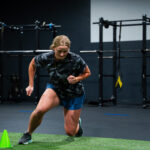Team Speed and Agility Training Drills
Speed wins games—but teamwork wins championships. That’s why team speed and agility training drills are so effective. They improve individual performance while building chemistry, communication, and competitiveness among teammates.
Whether you coach a soccer team, football squad, or a group of multisport athletes, group-based agility drills can transform how your athletes move together.
This article shares the best drills, strategies, and programming tips for team-based speed and agility training.
Why Train Speed and Agility as a Team?
When athletes train together, they push harder. Team drills create an environment of accountability, energy, and shared goals. Here’s why they work:
-
Increased motivation through friendly competition
-
Improved communication during dynamic movement
-
Game-like pressure and decision-making
-
Better transition from practice to performance
Group drills mimic chaotic game situations more accurately than solo drills. According to the NSCA, combining cognitive demands with speed and agility training enhances transfer to real sport performance.
Best Equipment for Team Training
You don’t need expensive tools to run team drills. Here’s what helps:
-
Agility cones for direction changes
-
Ladders for coordinated footwork
-
Resistance bands for strength-speed work
-
Numbered or colored markers for visual reaction drills
-
Stopwatch or timer app to track performance and rest
With just a field and a few cones, you can build an effective team speed session.
Top Team-Based Speed and Agility Drills
1. Mirror Shuffle Race
Partner athletes face each other in a low stance. One leads, one mirrors. Switch roles every 20 seconds.
Skills trained: Lateral quickness, reaction, control.
Why it works: Builds defensive footwork and reactive movement.
2. Relay Cone Sprints
Teams of 4 line up. Sprint one at a time to a cone 10 yards away and back. Tag the next runner.
Focus: Max effort sprint with fast change of direction.
Coaching tip: Keep rest short to simulate game fatigue.
3. Chase and Cut Drill
Two athletes sprint side-by-side. On coach’s signal, one becomes the leader and cuts at a cone. The other reacts and tries to follow.
Focus: Curved sprinting, reactive cutting.
Variation: Use ball-handling or passing during the cut.
4. 4-Corner Reactive Sprint
Set 4 cones in a square. Athletes start in the center. Coach calls a cone number. Sprint there and return to center.
Game tie-in: Simulates responding to unexpected movements.
Tip: Add ball drops or lights for visual cues.
5. Follow the Leader Ladder
Two athletes go through the ladder together. One leads with fast foot patterns. The other mimics the steps exactly.
Builds: Coordination, foot speed, and timing.
Optional: Add a race component to boost intensity.
Sample 30-Minute Team Session
Warm-Up (5–7 minutes):
-
High knees
-
Carioca
-
Lateral lunges
-
Leg swings
-
Quick line hops
Drill Circuit (20 minutes):
-
Mirror Shuffle Race – 3 sets
-
Chase and Cut Drill – 3 reps per athlete
-
Relay Cone Sprints – 2 rounds per team
-
4-Corner Reactive Sprint – 3 rounds
-
Follow the Leader Ladder – 3 sets
Cooldown (3–5 minutes):
-
Team jog
-
Partner hamstring stretch
-
Breathing drills for recovery
This layout encourages high effort, healthy competition, and skill transfer to live gameplay.
Coaching Tips for Team Agility Work
-
Keep it competitive but positive. Athletes perform best in supportive competition.
-
Balance work and rest. Use rest periods to give feedback and reset.
-
Focus on movement quality. Always coach proper form, angles, and posture.
-
Mix roles. Rotate leaders, followers, and partners to build team unity.
-
Use cues and commands. Reaction-based drills mirror live gameplay best.
Teams that train together improve faster and perform more cohesively.
Sport-Specific Team Adaptations
You can adapt these drills to suit your sport:
-
Football: Emphasize quick lateral and backward movement for defense.
-
Basketball: Focus on stop-start explosiveness and closeout footwork.
-
Soccer: Add ball control or passing after each drill for realism.
-
Volleyball: Train short, reactive movements in tight spaces.
Make sure each drill reflects real challenges athletes face in their sport.
Need sport-specific plans? Next Level Athletics offers team packages and custom programming for all levels.
Benefits Beyond the Field
Team speed and agility training improves:
-
Athletic bonding through shared challenge
-
Mental sharpness via reactive drills
-
Confidence under pressure
-
Coachability as athletes adapt on the fly
These benefits translate into better team culture and stronger performance in every game or event.
Conclusion: Teams That Move Together, Win Together
Speed and agility aren’t solo skills. They’re part of how a team functions together under pressure.
With the right drills, smart coaching, and a little competition, team speed and agility training builds sharper athletes and stronger teams. Everyone improves—not just physically, but mentally and strategically.
Start training as a team, and watch your performance rise together.


Recent Comments